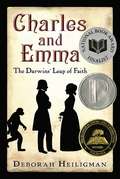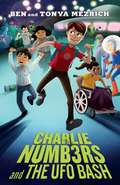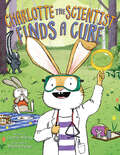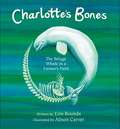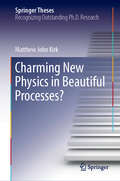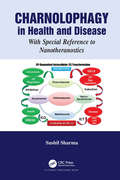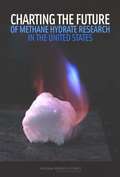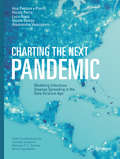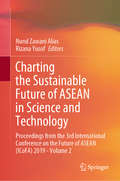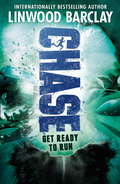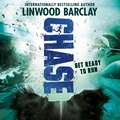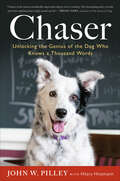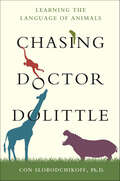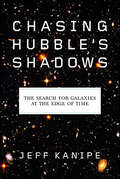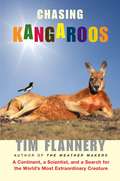- Table View
- List View
Charles Proteus Steinmetz
by Robert W. BlyRevered in the late 19th and early 20th centuries as a genius, but largely forgotten today, Steinmetz made the modern world possible through his revolutionary work on AC electricity transmission, the technology underlying today's power grid. More than just a great scientist and engineer, Steinmetz was also one of the most colorful characters in American life. Standing just four feet tall with a pronounced spine curvature, Steinmetz was as well known for his fiery political opinions, his fierce advocacy for social progress and education, his unusual home life, and his private menagerie as for his technical achievements.
Charles and Ada: The Computer's Most Passionate Partnership
by James Essinger Lisa Noel BabbageThe partnership of Charles Babbage and Ada Lovelace was one that would change science forever. They were an unlikely pair – one the professor son of a banker, the other the only child of an acclaimed poet and a social-reforming mathematician – but perhaps that is why their work was so revolutionary. They were the pioneers of computer science, creating plans for what could have been the first computer. They each saw things the other did not: it may have been Charles who designed the machines, but it was Ada who could see their potential. But what were they like? And how did they work together? Using previously unpublished correspondence between them, Charles and Ada explores the relationship between two remarkable people who shared dreams far ahead of their time.
Charles and Emma (The Darwins' Leap of Faith)
by Deborah HeiligmanCharles Darwin published "The Origin of Species", his revolutionary tract on evolution and the fundamental ideas involved, in 1859. 150 years later, the theory of evolution continues to create tension between the scientific and religious communities. This same debate raged within Darwin himself, and played an important part in his marriage: his wife, Emma, was very religious, and her faith challenged Charles as he worked on his theory of evolution.
Charles and Emma: The Darwins' Leap of Faith
by Deborah HeiligmanCharles Darwin published The Origin of Species, his revolutionary tract on evolution and the fundamental ideas involved, in 1859. Nearly 150 years later, the theory of evolution continues to create tension between the scientific and religious communities. Challenges about teaching the theory of evolution in schools occur annually all over the country. This same debate raged within Darwin himself, and played an important part in his marriage: his wife, Emma, was quite religious, and her faith gave Charles a lot to think about as he worked on a theory that continues to spark intense debates.Deborah Heiligman's new biography of Charles Darwin is a thought-provoking account of the man behind evolutionary theory: how his personal life affected his work and vice versa. The end result is an engaging exploration of history, science, and religion for young readers. Charles and Emma is a 2009 National Book Award Finalist for Young People's Literature.
Charlie Numbers and the UFO Bash (The Charlie Numbers Adventures)
by Ben Mezrich Tonya MezrichCharlie and the Whiz Kids must separate fact from otherworldly fiction as they set out to find their missing classmate in this action-packed fourth novel of the Charlie Numbers Adventures series.As his school&’s resident numbers guy, Charlie Lewis has always thought that if something can&’t be proven with a math equation, it might as well be myth—which is exactly how he feels about UFOs. Charlie just can&’t believe in the existence of aliens without verifiable proof. Not even Janice, who&’s the smartest kid Charlie knows, can convince him. But when Charlie&’s classmate Anthem mysteriously disappears after bringing a supposed space rock to show-and-tell, it&’s up the Whiz Kids to uncover the truth. As Charlie and the gang trace Anthem&’s steps to his eerily empty house, it soon becomes clear that perhaps Anthem and his father are involved in something much bigger than a lost rock. From meeting with UFO enthusiasts, sneaking into hidden rooms, and being following by shadowy and dangerous agents, Charlie is finding it more and more difficult to stick to his convictions—because what if aliens do exist?
Charlie Numbers and the Woolly Mammoth (The Charlie Numbers Adventures)
by Ben Mezrich Tonya MezrichCharlie and the Whiz Kids discover a prehistoric mammoth tusk and stumble right into the nefarious clutches of an eccentric billionaire in this hilarious third novel of the Charlie Numbers series.Charlie Numbers and his gang of Whiz Kids—along with a few new allies—are on another mission: this time, to uncover the truth behind the mysterious mammoth tusk they found buried in the Boston Public Gardens. Their hunch? Blake Headstrom, eccentric billionaire, philanthropist, and collector of some renown, has been smuggling mammoth tusks into the city. The only question is: Why? Selling woolly mammoth tusks isn&’t illegal…but selling elephant ivory is. And Charlie&’s certain Headstrom&’s plans are more sinister than they seem. But Headstrom is a powerful man, with powerful connections. If the Whiz Kids want to expose him for the criminal they know he is, they&’re going to have to catch him red-handed. Now if only Headstrom&’s henchmen weren&’t lurking at every turn…
Charlotte the Scientist Finds a Cure (Charlotte the Scientist)
by Camille AndrosIn this empowering picture book with a STEM focus, Charlotte, a budding bunny scientist, ignores the doubters and confidently finds a cure to the mysterious malady affecting the forest. The animals of the forest are all getting sick and no one can figure out why. Determined to get to the bottom of the mystery and help her friends and family, Charlotte dives into some serious medical science. But when the doctors and other scientists don&’t take her work seriously, she sets out to find a cure on her own, determined to show that she can make a difference. This empowering story about a smart, confident bunny encourages girls to be persistent and believe in themselves.
Charlotte the Scientist Is Squished (Charlotte the Scientist)
by Camille Andros Brianne FarleyCharlotte is a serious scientist. She solves important problems by following the scientific method. She has all the right equipment: protective glasses, a lab coat, a clipboard, and a magnifying glass. What she doesn’t have is space. She has so many brothers and sisters (she is a rabbit, after all) that she is too squished to work on her experiments! Can she use science to solve her problem? This funny, satisfying story is a playful introduction to the scientific method and perfect for sparking an interest in STEM subjects.
Charlotte's Bones: The Beluga Whale In A Farmer's Field (Tilbury House Nature Book #0)
by Erin Rounds Alison CarverMany thousands of years ago, when a sheet of ice up to a mile thick began to let go of the land, the Atlantic Ocean flooded great valleys that had been scooped out by glaciers, and the salty waves of an inland sea lapped the green hills of Vermont. Into this arm of the sea swam Charlotte. Her milky, smooth, muscled body sliced slowly through the water like scissors through silk. Like a chirping canary, her voice echoed across dark waters showing the way to her pod as belugas have done for millions of years. In 1849, a crew building a railroad through Charlotte, Vermont, dug up strange and beautiful bones in a farmer’s field. A local naturalist asked Louis Agassiz to help identify them, and the famous scientist concluded that the bones belonged to a beluga whale. But how could a whale’s skeleton have been buried so far from the ocean? The answer—that Lake Champlain had once been an arm of the sea—encouraged radical new thinking about geological time scales and animal evolution. Charlotte’s Bones is a haunting, science-based reconstruction of how Charlotte died 11,000 years ago in a tidal marsh, how the marsh became a field, how Charlotte found a second life as the Vermont state fossil, and what messages her bones whisper to us now about the fragility of life and our changing Earth. Lexile 940; F&P Level P
Charm Production in Deep Inelastic Scattering: Mellin Moments of Heavy Flavor Contributions to F2(x,Q^2) at NNLO (Springer Theses)
by Sebastian KleinThe production of heavy quarks in high-energy experiments offers a rich field to study, both experimentally and theoretically. Due to the additional quark mass, the description of these processes in the framework of perturbative QCD is much more demanding than it is for those involving only massless partons. In the last two decades, a large amount of precision data has been collected by the deep inelastic HERA experiment. In order to make full use of these data, a more precise theoretical description of charm quark production in deep inelastic scattering is needed. This work deals with the first calculation of fixed moments of the NNLO heavy flavor corrections to the proton structure function F2 in the limit of a small charm-quark mass. The correct treatment of these terms will allow not only a more precise analysis of the HERA data, but starting from there also a more precise determination of the parton distribution functions and the strong coupling constant, which is an essential input for LHC physics. The complexity of this calculation requires the application and development of technical and mathematical methods, which are also explained here in detail.
Charming Decays of the Higgs, Z, and W Bosons: Development and Deployment of a New Calibration Method for Charm Jet Identification (Springer Theses)
by Spandan MondalThis book presents searches for the Higgs boson, Z boson, and W boson decaying into charm quark(s) performed with proton-proton collision data at √s = 13TeV collected by the CMS experiment at the LHC, CERN, corresponding to an integrated luminosity of 138 fb−1 and recorded between 2016 and 2018. The searches are carried out using events in which the Higgs/Z/W boson is produced in association with a leptonically-decaying Z or W boson. This thesis also discusses a novel calibration algorithm for charm jet identification that enables maximal use of the available information related to charm jets. The new method is used to correct the entire distribution expected as output when jet flavour identification algorithms are applied to jets of different flavours. The calibrated results improve over traditional efficiency measurements and help enhance the sensitivities of the Higgs, Z, and W searches. This book primarily reports on the so-called resolved-jet topology of the Higgs/Z/W boson searches, where the boson candidates are reconstructed using two separate small-radius (AK4) jets. Upon statistically combining the results of the resolved-jet search with a complementary merged-jet approach, the observed (expected) upper limit on the Higgs decay to charm quarks corresponds to 14 (7.6) times the Standard Model expectation at the 95% CL which is the most stringent direct limit to date. A significance of 5.7σ (5.9σ) over the background-only prediction is observed (expected) in case of the search for charmed Z boson decays. Only the resolved-jet topology is used in the search for charmed W decays and the observed (expected) significance is 5.6σ (5.7σ) over the background-only prediction. These mark the first observations of charmed decays of the Z and W bosons at a hadron collider experiment.
Charming New Physics in Beautiful Processes? (Springer Theses)
by Matthew John KirkThis PhD thesis is dedicated to a subfield of elementary particle physics called “Flavour Physics”. The Standard Model of Particle Physics (SM) has been confirmed by thousands of experimental measurements with a high precision. But the SM leaves important questions open, like what is the nature of dark matter or what is the origin of the matter-antimatter asymmetry in the Universe. By comparing high precision Standard Model calculations with extremely precise measurements, one can find the first glimpses of the physics beyond the SM – currently we see the first hints of a potential breakdown of the SM in flavour observables. This can then be compared with purely theoretical considerations about new physics models, known as model building. Both precision calculations and model building are extremely specialised fields and this outstanding thesis contributes significantly to both topics within the field of Flavour Physics and sheds new light on the observed anomalies.
Charnolophagy in Health and Disease: With Special Reference to Nanotheranostics
by Sushil SharmaThis book introduces charnolophagy (CP) as energy-driven, lysosomal-dependent mitochondrial inclusion-specific pleomorphic Charnoly body (CB) autophagy (ATG) involving free radical-induced Ca2+ dyshomeostasis, ΔΨ collapse, and ATP depletion in congenital diseases, pressure ulcers, metabolic diseases, hepatic diseases, diabetes, obesity, inflammatory diseases, musculoskeletal diseases, sarcopenia, cachexia, respiratory diseases, gastrointestinal diseases, hyperlipidemia, skin and hair diseases, pulmonary diseases, cardiovascular diseases, renal diseases, sepsis-induced multi-organ failure, reproductive diseases, inflammatory diseases, ophthalmic diseases, neurodegenerative diseases, drug addiction, aging, microbial (including COVID-19) infections, and belligerent malignancies implicated in early morbidity and mortality and disease-specific spatiotemporal, targeted, safe, and effective evidence-based personalized theranostic charnolopharmacotherapeutics to cure them. Basic DRESS and GELS principles, nanoparticles to cure chronic multidrug-resistant (MDR) diseases, antioxidants as free radical scavengers, CB antagonists, CP regulators, and CS stabilizers to curb CB molecular pathogenesis (CBMP) are described for better quality of life and longevity. Specific guidelines for environmental protection and preservation of zoological and botanical species at the verge of extinction, Triple "I" Hypothesis for mitochondrial quality control, and transcriptional regulation of CSexR and CSendoR to cure chronic diseases are presented. Novel CP index is introduced to evaluate MDR malignancies and other chronic diseases. WHO, CDC, FDA, NIH, policy planners, cosmetologists, trichologists, players, athletes, dancers, wrestlers, equestrians, young women, aging population, toxicologists, environmental protectionists, pharmaceutical industry, biomedical scientists, researchers, medical students, physicians, nurses, paramedical professionals, and global audience will be interested in this interesting book to prevent pandemics and raise healthcare awareness.
Charophytes of Europe
by Thomas Gregor Michelle T. Casanova Hendrik Schubert Irmgard Blindow Emile Nat Heiko Korsch Luc Denys Nick Stewart Klaus van de Weyer Roman RomanovThis book covers whole Europe within its geographical limits, providing not only an overview about biogeography and recent taxonomic status of Charophyte species but also in-depth information about recent knowledge about ecology, ontogenesis, morphology, palaeontology and systematics of this group of algae. This is the first comprehensive treatment of European Charophytes. In addition, the reader for the first time is provided by definitions of terms applied to Charophytes, sorting out several previous confusions about terminology. Special attention was paid on oospores in order to exploit their potential for supporting species delineation as well as analysis of sediment records. A red list, dealing also with threats and habitat conditions, completes the book.Altogether more than 70 taxon are described in detail, each of the descriptions giving full information about morphology, habitat conditions, distribution as well as variability; important characters for determination are illustrated by photographs and drawings. Hints for correct determination are given in a separate para, allowing correct species delineation even for critical species. This, together with a set of determination keys, will allow beginners and practitioners to get familiar with the determination of Charophytes, being often regarded notoriously difficult in the past.Authored by a large group of 70 specialists from all over Europe and Overseas, a commonly agreed taxonomy is provided, and all debates about taxonomic status and nomenclatural problems have been discussed beforehand extensively. By this, a sound reference for applied aspects is given, allowing for reliable cross-country comparisons especially with respect to bioindication purposes but also serving ground for biogeographical research, biodiversity issues and the emerging field of elucidating the process of territorialisation of land plants. The authors hope that this book will become the reference work for the coming decades it was designed for.
Charting Environmental Law Futures in the Anthropocene
by Michelle LimThis book explores a range of plausible futures for environmental law in the new era of the Earth’s history: the Anthropocene. The book discusses multiple contemporary and future challenges facing the planet and humanity. It examines the relationship between environmental law and the Anthropocene at governance scales from the global to the local. The breadth of issues and jurisdictions covered by the book, its forward-looking nature, and the unique generational perspective of the contributing authors means that this publication appeals to a wide audience from specialist academics and policy-makers to a broader lay readership.
Charting The Future Of Methane Hydrate Research In The United States
by Committee to Review the Activities Authorized Under the Methane Hydrate Research Development Act of 2000Methane hydrate is a natural form of clathrate - a chemical substance in which one molecule forms a lattice around a "guest" molecule with chemical bonding. In this clathrate, the guest molecule is methane and the lattice is formed by water to form an ice-like solid. Methane hydrate has become the focus of international attention because of the vast potential for human use worldwide. If methane can be produced from hydrate, a reasonable assumption given that there are no obvious technical or engineering roadblocks to commercial production, the nation's natural gas energy supply could be extended for many years to come. This report reviews the Department of Energy's (DOE) Methane Hydrate Research and Development Program, the project selection process, and projects funded to date. It makes recommendations on how the DOE program could be improved. Key recommendations include focusing DOE program emphasis and research in 7 priority areas; incorporating greater scientific oversight in the selection, initiation, monitoring, and assessment of major projects funded by the DOE; strengthening DOE's contribution to education and training through funding of fellowships, and providing project applicants with a set of instructions and guidelines outlining requirements for timely and full disclosure of project results and consequences of noncompliance.
Charting the Next Pandemic: Modeling Infectious Disease Spreading in the Data Science Age
by Alessandro Vespignani Luca Rossi Bruno Gonçalves Nicola Perra Ana Pastore y Piontti Nicole Samay Corrado Gioannini Marcelo F. GomesThis book provides an introduction to the computational and complex systems modeling of the global spreading of infectious diseases. The latest developments in the area of contagion processes modeling are discussed, and readers are exposed to real world examples of data-model integration impacting the decision-making process. Recent advances in computational science and the increasing availability of real-world data are making it possible to develop realistic scenarios and real-time forecasts of the global spreading of emerging health threats.The first part of the book guides the reader through sophisticated complex systems modeling techniques with a non-technical and visual approach, explaining and illustrating the construction of the modern framework used to project the spread of pandemics and epidemics. Models can be used to transform data to knowledge that is intuitively communicated by powerful infographics and for this reason, the second part of the book focuses on a set of charts that illustrate possible scenarios of future pandemics. The visual atlas contained allows the reader to identify commonalities and patterns in emerging health threats, as well as explore the wide range of models and data that can be used by policy makers to anticipate trends, evaluate risks and eventually manage future events.Charting the Next Pandemic puts the reader in the position to explore different pandemic scenarios and to understand the potential impact of available containment and prevention strategies. This book emphasizes the importance of a global perspective in the assessment of emerging health threats and captures the possible evolution of the next pandemic, while at the same time providing the intelligence needed to fight it. The text will appeal to a wide range of audiences with diverse technical backgrounds.
Charting the Sustainable Future of ASEAN in Science and Technology: Proceedings from the 3rd International Conference on the Future of ASEAN (ICoFA) 2019 - Volume 2
by Nurul Zawani Alias Rizana YusofThis book showcases selected conference papers addressing the sustainable future of ASEAN from the perspectives of science and technology disciplines. In addressing the 17 Sustainable Developments Goals (SDGs) envisioned by the United Nations in the domains of environment, health and well-being, posing potential means of reducing inequalities globally, the authors target specific issues and challenges confronting the fast-growing region of ASEAN and present suggestions for co-operation and commitment from governments, non-governmental organisations (NGOs) and society at large, in line with the ASEAN Vision 2020. Papers are selected from the 3rd International Conference on the Future of ASEAN (ICoFA) 2019, organised by Universiti Teknologi MARA in Malaysia, whose conference theme “Charting the Sustainable Future of ASEAN” enables intellectual discourse on sustainability issues from science and technology, as well as business and the social sciences. The selection of papers is published in two books, comprised of scholarly and practical insights on sustainability in ASEAN. This book from science and technology scholars is of interest to researchers and policymakers interested in sustainability developments in the ASEAN region.
Chase: Book 1 (Chase #1)
by Linwood BarclayGet ready to run . . . an edge-of-your-seat thriller with bite from international bestselling author Linwood Barclay, in his first novel for 9-12 year olds.Chipper is a very special dog. As part of a top-secret, multi-million dollar experiment to create the ultimate canine spy technology, Chipper's whole life has been spent within the walls of a secret organization known only as The Institute. Chipper is supposed to be more machine than mutt, but something's wrong and The Institute knows it. He's about to be terminated.Across the state, twelve-year-old orphan Jeff Conway is working all hours at his aunt Flo's lakeside cabin business. He misses his parents, his old life, and the dog he had to leave behind.When Chipper escapes and his and Jeff's paths collide, dog and boy find themselves tangled up in the most dangerous game of chase imaginable...Winner of the Arthur Ellis award for Best Kid's Crime NovelDanger, secrets and thrilling suspense in Linwood Barclay's action-packed first novel for children.
Chase: Book 1 (Chase #1)
by Linwood BarclayGet ready to run . . . an edge-of-your-seat thriller with bite from international bestselling author Linwood Barclay, in his first novel for ages 9+.Chipper is a very special dog. As part of a top-secret, multi-million dollar experiment to create the ultimate canine spy technology, Chipper's whole life has been spent within the walls of a secret organization known only as The Institute. Chipper is supposed to be more machine than mutt, but something's wrong and The Institute knows it. He's about to be terminated.Across the state, twelve-year-old orphan Jeff Conway is working all hours at his aunt Flo's lakeside cabin business. He misses his parents, his old life, and the dog he had to leave behind.When Chipper escapes and Jeff finds himself part of the chase, The Institute's most ruthless agent is hot on their tail, and he wants Chipper dead . . . at any cost.Danger, secrets and thrilling suspense collide in Linwood Barclay's action-packed first novel for children.(P) 2017 Orion Children's Books
Chase: Book 1 (Chase Ser. #1)
by Linwood BarclayGet ready to run . . . an edge-of-your-seat thriller with bite from international bestselling author Linwood Barclay, in his first novel for 9-12 year olds.Chipper is a very special dog. As part of a top-secret, multi-million dollar experiment to create the ultimate canine spy technology, Chipper's whole life has been spent within the walls of a secret organization known only as The Institute. Chipper is supposed to be more machine than mutt, but something's wrong and The Institute knows it. He's about to be terminated.Across the state, twelve-year-old orphan Jeff Conway is working all hours at his aunt Flo's lakeside cabin business. He misses his parents, his old life, and the dog he had to leave behind.When Chipper escapes and his and Jeff's paths collide, dog and boy find themselves tangled up in the most dangerous game of chase imaginable...Winner of the Arthur Ellis award for Best Kid's Crime NovelDanger, secrets and thrilling suspense in Linwood Barclay's action-packed first novel for children.
Chaser: Unlocking the Genius of the Dog Who Knows a Thousand Words
by Hilary Hinzmann John W. Pilley“This marvelous blend of good science and heartwarming dog story will inspire all of us to reexamine our canine friends.” —Booklist, starred reviewThe New York Times–bestselling story of a very smart Border collie who redefined animal intelligence. A joyous explanation of behavior, learning, and perception—any pet owner, parent, teacher, or psychologist will be enriched by this book.When retired psychology professor John Pilley first got his new Border collie puppy, Chaser, he wanted to explore the boundaries of language learning and communication between humans and man’s best friend. Exhibiting intelligence previously thought impossible in dogs, Chaser soon learned the names of more than a thousand toys and sentences with multiple elements of grammar.Chaser’s accomplishments are revolutionizing the way we think about the intelligence of animals. John and Chaser’s inspiring journey demonstrates the power of learning through play and opens our eyes to the boundless potential in the animals we love.“The most scientifically important dog in over a century.” —Brian Hare, founder of the Duke Canine Cognition Center and coauthor of The Genius of Dogs“After you read Chaser, you will realize that you may have underestimated the intelligence of your dog. Marvelous insights into a dog’s mind.” —Temple Grandin, author of Animals in Translation and Animals Make Us Human“Dogs and those of us who love them owe to debt of gratitude to the brilliant, courageous author and his equally heroic subject.” —Jennifer Arnold, author of Through a Dog’s Eyes“An engrossing and remarkable tale.” —The Bark “A delightful memoir that offers a challenge to behavioral psychologists and inspiration for pet lovers.” —Kirkus Reviews
Chasing Doctor Dolittle: Learning the Language of Animals
by Con Slobodchikoff"Slobodchikoff's ground-breaking research" (Jonathan Balcombe) shows us that animals have much to teach us about languageGroundbreaking research has been done teaching animals human language, but what about the other way around? Studies have shown that lizards, squid, monkeys, and birds are talking to each other, communicating information about food, predators, squabbles, and petty jealousies. These animal languages are unique and highly adaptive. By exploring them, we come to appreciate the basis of our own languages; understanding or even "speaking" them allows us to get closer to the other species who inhabit this planet with us. The implications of animals having language are enormous. It has been one of the last bastions separating "us" from "them."Slobodchikoff's studies of the communication system of prairie dogs over twenty-five years have attracted a considerable amount of attention from the media, including a one-hour documentary on his work produced by BBC and Animal Planet. In Chasing Doctor Dolittle, he posits that the difference is one of degree, not the vast intellectual chasm that philosophers have talked about for millennia. Filled with meticulous research, vivid examples and daring conclusions, this book will challenge the reader's assumptions and open up new possibilities of understanding our fellow creatures.
Chasing Hubble's Shadows: The Search for Galaxies at the Edge of Time
by Jeff KanipeChasing Hubble's Shadows is an account of the continuing efforts of astronomers to probe the outermost limits of the observable universe. The book derives its title from something the great American astronomer Edwin Hubble once wrote: "Eventually, we reach the dim boundary—the utmost limits of our telescopes. There, we measure shadows, and we search among ghostly errors of measurement for landmarks that are scarcely more substantial." The quest for Hubble's "shadows"—those unimaginably distant, wispy traces of stars and galaxies that formed within the first few hundred million years after the Big Bang—takes us back, in effect, to the beginning of time as we are able to perceive it, when the first discrete stellar objects appeared out of what has lately come to be known as the "cosmic dark age." The information that is being gleaned from these dim sources—chiefly with the aid of Hubble's namesake, the Hubble Space Telescope—promises to yield clues to many cosmic puzzles, including the nature of the mysterious "dark energy" that is now believed to pervade all of space.
Chasing Kangaroos: A Continent, a Scientist, and a Search for the World's Most Extraordinary Creature
by Tim FlanneryIn his most personal book yet, Tim Flannery draws on three decades of travel, research, and field work to craft a love letter to his native land and one of its most unique and beloved inhabitants: the kangaroo.


